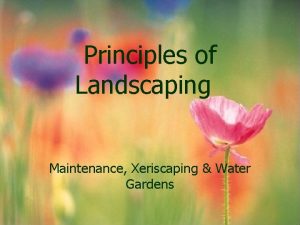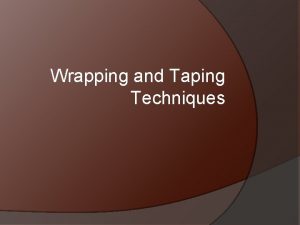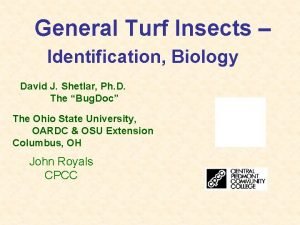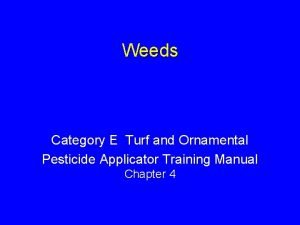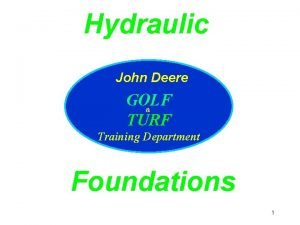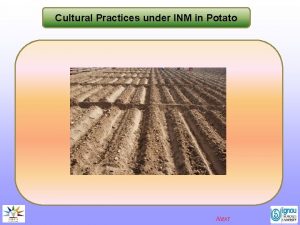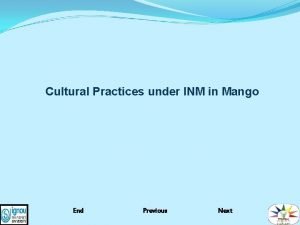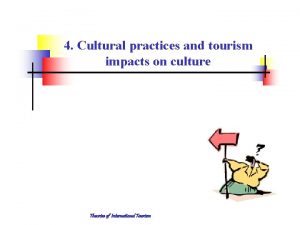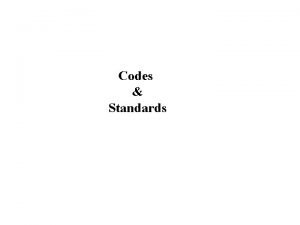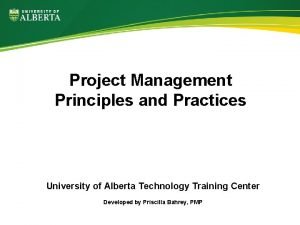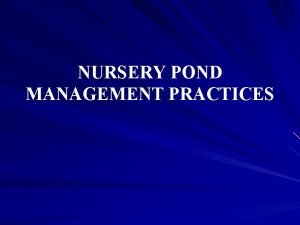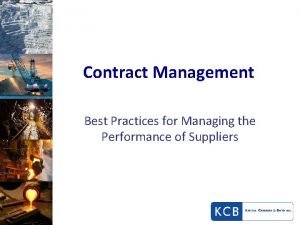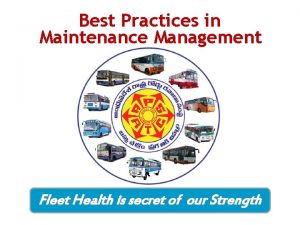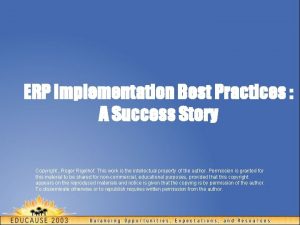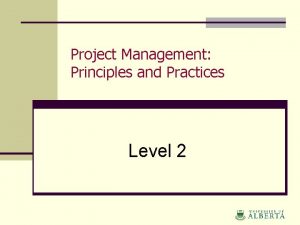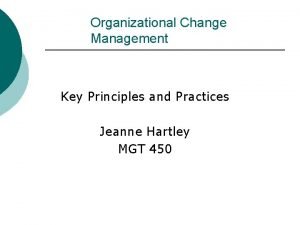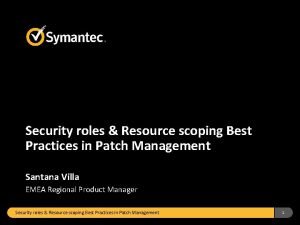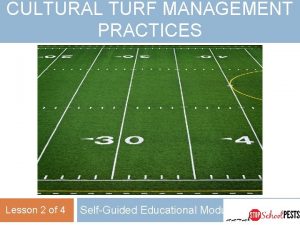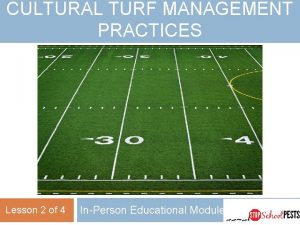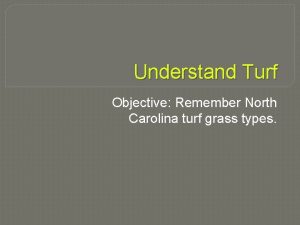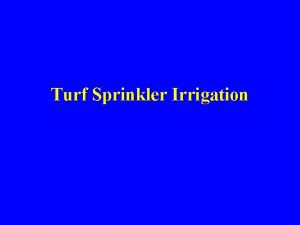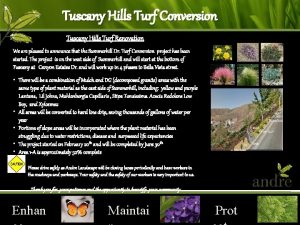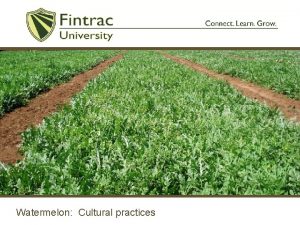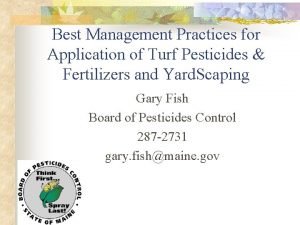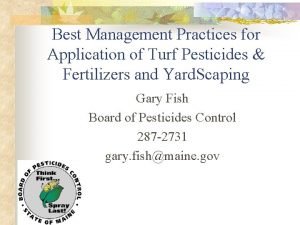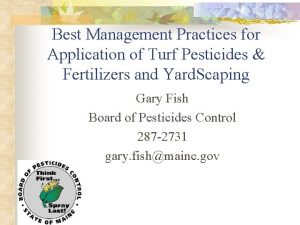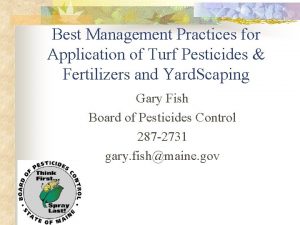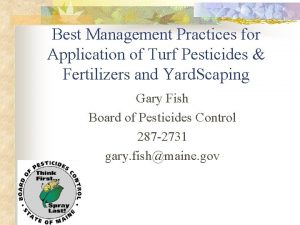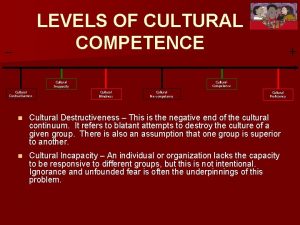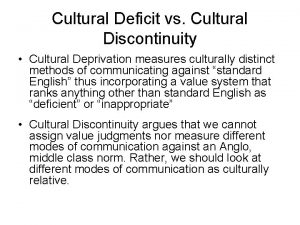CULTURAL TURF MANAGEMENT PRACTICES Lesson 2 of 4






































- Slides: 38

CULTURAL TURF MANAGEMENT PRACTICES Lesson 2 of 4 Self-Guided Educational Module

Learning Objectives 2 1. Understand cultural turf management practices including: a. Mowing b. Fertilization c. Irrigation d. Soil Analysis e. Aeration f. Overseeding

Mowing 3 Keep mower blades sharp to provide a clean cut, this minimizes disease q Minimize scalping and soil compaction and rutting of playfields by rotating the direction of mowing each time the lawn is clipped q Keep mowers in good repair; leaking oil, gasoline fuel, leaky hydraulic lines and grease can damage or kill turf q

Mowing 4 The One-Third Rule q To sustain vigorous turf, remove no more than onethird of height of the grass from soil level at any one mowing event Mowing height q Mow tall to encourage deeper rooting, which will improve tolerance to environmental stress and reduce the need for fertilizer and pesticides q Most non-athletic turfgrasses used on school lawns can be mowed at a height of 2 ½ -3 inches (there are exceptions) For example, bentgrass grown west of the Cascades should be mowed at less than 1 inch

Mowing 5 q q q To adhere to the 1/3 rule, mow your turf at least once a week If possible mow high priority areas such as athletic fields twice a week during periods of heavy growth Increased mowing frequency will increase turf density, wear tolerance and decrease weed encroachment

Mowing 6 4. 5” 4” 3” 3” Height prior to mowing The one-third rule Height after mowing 6” 2” 1. 5” 1” Alec Kowaleski, Oregon State University

Mowing 7 High Cut Low Cut The picture depicts the effect of mowing height on root growth A lower cut produces shorter roots, less stress tolerance and allows more weed

When to Mow 8 Mow when the lawn is dry to minimize the chance of spreading diseases Dry clippings almost never need to be removed from turf Clippings do not contribute to thatch Clippings return nutrients to the soil decreasing fertility requirements q

Fertilization 9 A basic soil test will identify the soil p. H/lime requirements, as well as phosphorus, potassium and secondary nutrient deficiencies Soil test labs may provide recommendations Alec Kowaleski, Oregon State University

1. Fertilization 10 q q q All grasses require certain nutrients, including nitrogen (N), phosphorus (P) and potassium (K) There are no generic N fertilization recommendations that apply to all situations Fertilizing with P should be based on a soil test Fertilizing with N should be based on turfgrasses present, site and use of turf Use a fertilizer that supplies a higher concentration of nitrogen and low concentration of phosphorus, or approximately a 3: 2: 1 ratio of nitrogen to phosphorus to potassium

Fertilization 11 In several states (WA, MN, WI and others), fertilizers containing phosphorus cannot be applied unless a soil test documents a deficiency, to protect lakes, rivers and streams Soil test results will provide specifics on the phosphorus rates

Fertilization 12 There are two basic forms of nitrogen contained in fertilizer products Ø Water-soluble nitrogen (WSN) which is readily available to the plant Ø Slow-release nitrogen (SRN) which is available in the form of water-insoluble nitrogen (WIN) or controlled-release nitrogen Ø Manufactured turf fertilizers are often formulated with a mixture of WSN and

Fertilization 13 The percentages of WSN and SRN in a fertilizer product will affect the N-release rate, price and other factors Characteristics of WSN and SRN sources may be considered either advantageous or disadvantageous depending on the specific management situation

Fertilization 14 Use the lowest product rate possible that will meet your expectations for growth, appearance, and produce healthy turf q Slow-release fertilizers will: Ø Prolong the availability of nutrients throughout the growing season Ø Reduce the risk of water pollution Ø Compost, depending on the parent materials, can also be a source of P and should be factored into the fertilization q

When to Use Fertilizer 15 q q q Timing and rate of fertilizer applications depend on: Ø The requirements of the turfgrass species Ø Your expectations for turf quality and turf density Ø Seasonal limitations and the use of the area Ø Application rates range from 0. 5 to 1. 5 lbs N per 1, 000 ft 2, split applications so that no more than ¼ lb of water-soluble N is applied in any one application A soil test should be the basis for planning fertilization schedules In high maintenance areas, testing every year will

Irrigation Frequency 16 Water deeply but infrequently, based on need, to encourage a deep root system How frequently you irrigate depends on the soil type, weather conditions, species of grass and the mowing height and use of the turf Delay irrigation in the spring to encourage roots to grow deeper to seek moisture

Irrigation Amount 17 Supplement rainfall to provide a total of one inch of water per week It takes 620 gallons of water to apply one inch of water to 1000 ft 2 of turf, it’s best applied in several applications to avoid runoff and saturation Overwatering reduces root growth, promotes compaction and disease activity and decreases overall wear tolerance

1. Irrigation Timing 18 Water turf just before it begins to wilt, signs of wilting include: Ø A bluish-green or purplish color to the grass Ø Rolling or folding blades of grass Ø Footprints that remain on the lawn for several minutes after passage Ø Soil that is dry at the soil surface; penetration with a screwdriver is tough

Irrigation Timing Continued 19 Water turf very early in the morning, this can limit evaporation and reduces disease problems q Extended periods of leaf wetness caused by high humidity, excessive watering and standing water encourages fungal diseases q All areas of the lawn should receive adequate coverage and low spots should be leveled or drained to avoid waterlogged soils q

Soil Analysis 20 An uninformed approach to soil and nutrient management is neither economically viable nor environmentally responsible Basic soil test results can dictate approaches to soil management, assessment of overall plant health, refinement of a fertility program, prevention of nutrient losses to the environment and other aspects of management

Soil Analysis 21 Sample soil and conduct chemical and physical soils analysis prior to establishment, renovation or at the beginning of assuming management responsibility for a site where limited history is available

Soil Analysis 22 Soil Chemical Properties E. g. , p. H, fertility, nutrient reserves, heavy metals, salinity • Provides information about the growing conditions plants will be exposed to • Determines fertilizer and p. H adjustment Soil Physical Properties E. g. , texture, particle size distribution, percent organic matter • Provides information about soil health • Helps indicate drainage characteristics and the compatibility of

Soil Analysis 23 For established, healthy turf, conduct soil chemical analyses at least every three years and monitor p. H annually Soil profile q Test soil conditioners, topdressing materials, composts and other turf amendments separately to ensure suitability for use q

Soil Analysis 24 Learn how to correctly interpret soil test results Soil test results are of little value without an appropriate interpretation As the soil test level for a nutrient increases, plant growth increases to a point where the nutrient is no longer limiting; this point is known as the critical soil test level The critical soil test level is defined as the extractable nutrient concentration in soil above which improved plant growth or

Soil Analysis 25 Nutrient levels are considered sufficient when the concentration is just above the critical soil test level This is known as the optimum soil test range

Soil Analysis 26 When levels are below the optimum range (very low or low), the addition of more nutrients will usually improve turf performance When soil test levels are in the optimum range turf response to application of that nutrient is unlikely, but some amount may be recommended to maintain soil levels over time There are do-it-yourself soil test kits or soil

Soil Analysis 27 Factors other than nutrients may limit turfgrass growth, and simply adding more nutrients may not improve turf performance To optimize turf performance and maximize response to fertilizer, sound management practices must be used including cultivar selection, establishment, irrigation management and pest and stress management

Interpretation of Soil Test Categories 28 Categorie s Interpretation Very Low Substantial amounts of additional nutrients required to achieve optimum growth Fertilizer rates should be based on plant response and are designed to gradually increase soil nutrient levels to the optimum range over several years Low Moderate amounts of additional nutrients needed to achieve optimum growth Recommendations based on plant response and are intended to gradually increase soil nutrient levels to the optimum range Optimum Most desirable soil test range on economic and environmental basis To maintain this range for successive years, nutrients must be retained in the system, or those nutrients lost or consumed must be replaced Above optimum The nutrient is considered more than adequate and will not limit the plants At the top end of this range, there is the possibility of a negative impact on the turf if nutrients are added

Aeration 29 Aeration is the process of making holes in the turf to improve air exchange, help water penetrate and drain and decrease the soil density and organic matter q Soil compaction occurs when lawns are used heavily and the pore spaces that allow water and air to pass through the soil collapse, creating poor conditions for root growth q Aeration promotes growth, helps manage thatch buildup and relieves soil compaction q

Aeration 30 Hollow tine core cultivation q Unlike other aerification methods, this method improves drainage, reduces organic matter and relieves compaction by pulling cores from soil Aeration of turf - David Kopec, University of Arizona

Aeration 31 Pulverize and distribute the cores over the field with a steel drag mat to distribute the soil, this is a great time to overseed q Top dressing with compost (ideally over aeration holes) and rotating mowing patterns also helps relieve soil compaction q

When to Aerate 32 The soil must be moist enough to allow good penetration but not too moist that machinery will rut or compact the soil q Irrigate area at least one day before aerating and check depth and amount of soil moisture q Time aeration efforts to avoid periods when weeds are producing seed or when the grass will not recuperate quickly such as in high heat conditions q

When to Aerate 33 Practice fields should be aerated one to three times a year q Lawns should be aerated one time a year or less depending on use q Heavily used turf may require aeration up to four times a year q Turf shoot growth - Alec Kowaleski, Oregon State University

1. Overseeding 34 Overseeding generally means: q Introducing more seed of the same grass type into the established turf or q Spreading seed of a different type as environmental conditions change Ø For example, when cool-season turf is seeded into warm-season turf during the winter

1. Overseeding 35 Overseeding helps: Ø Thicken the turf stand Ø Avoid excessive compaction Ø Minimize soil erosion Ø Prevent weed seed germination q Overseeding is usually performed using a spreader which may be a drop or rotary design q

Overseeding 36 q q Slit seeding or drilling places the seed directly in the soil Usually a single pass is sufficient, but bare areas require multiple passes in two to three directions to provide sufficient seed Spot seeding with a fast germinating turf should be done any time there is an open area caused by weed control, turf removal or winter damage, grubs, etc. Broadcast seeding is performed a variety of ways and may be combined with aeration

Check In! 37 This lesson you learned: 1. Cultural turf management practices including: Mowing Ø Fertilization Ø Irrigation Ø Soil Analysis Ø Aeration Ø Overseeding Next you will learn more about common turfgrass weeds and insects! Ø

Resource List 38 q q q Iowa State University. (2010). Plant and Insect Diagnostic Clinic. http: //www. ipm. iastate. edu/ipm/info/plant-diseases/turf-grass-rust Maine Department of Agriculture, Conservation and Forestry. School IPM. http: //www. maine. gov/dacf/php/integrated_pest_management/school /index. shtml Rutgers Cooperative Extension. IPM Report Card for School Grounds: General Requirements. http: //entomology. osu. edu/schoolipm/IPMfiles/Report. Card. General. p df Texas A&M Agrilife Extension. Landscape IPM Module 6. http: //schoolipm. tamu. edu/videodvd/ Umass Extension Center for Agriculture. Best Management Practices For Lawn and Landscape Turf. http: //extension. umass. edu/turf/sites/turf/files/pdf-doc-
 Turf areas in xeriscaping designs should be seeded in
Turf areas in xeriscaping designs should be seeded in Turf toe
Turf toe Contact sports
Contact sports What is good nitrogen fertilizer
What is good nitrogen fertilizer Bermuda mites
Bermuda mites Category e turf and ornamentals
Category e turf and ornamentals Hydraulic cylinders for turf maintenance
Hydraulic cylinders for turf maintenance Cultural representations and signifying practices
Cultural representations and signifying practices Define cultural practices
Define cultural practices Cultural practices
Cultural practices Cultural practices of mango
Cultural practices of mango Define cultural practices
Define cultural practices Code standards and practices 1 lesson 1
Code standards and practices 1 lesson 1 Prm vs crm
Prm vs crm Contemporary issues in supply chain management ppt
Contemporary issues in supply chain management ppt Security management practices
Security management practices It infrastructure project management best practices
It infrastructure project management best practices Project management principles and practices
Project management principles and practices Pre stocking management of fish pond
Pre stocking management of fish pond Sales territory management best practices
Sales territory management best practices Data quality management best practices
Data quality management best practices Grant management best practices
Grant management best practices Contract monitoring best practices
Contract monitoring best practices Fleet maintenance management system best practices
Fleet maintenance management system best practices It infrastructure management best practices
It infrastructure management best practices Critical practices in software project management
Critical practices in software project management Best practice erp implementation
Best practice erp implementation Management practices of dhirubhai ambani
Management practices of dhirubhai ambani Treasury best practices
Treasury best practices Periodic billing
Periodic billing Prudent financial management
Prudent financial management Project management principles and practices
Project management principles and practices Change management principles and practices
Change management principles and practices Expense management best practices
Expense management best practices Panel management best practices
Panel management best practices Altiris patch management best practices
Altiris patch management best practices Contract management best practices matrix
Contract management best practices matrix Safety practices and sports injury management pictures
Safety practices and sports injury management pictures Disability management best practices
Disability management best practices
